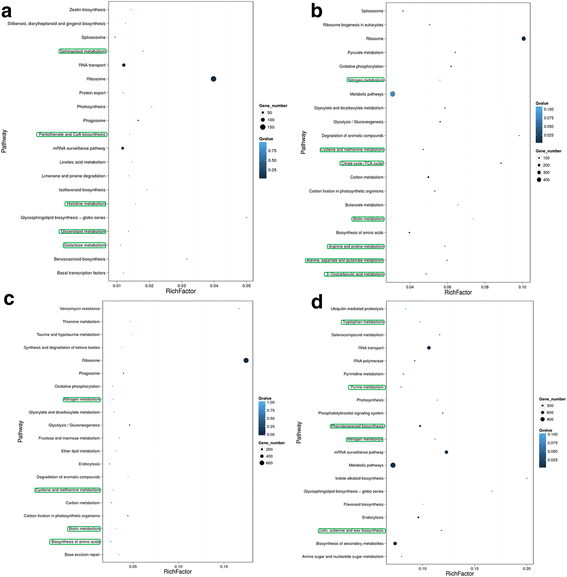Integrated omics data of two annual ryegrass (Lolium multiflorum L.) genotypes reveals core metabolic processes under drought stress
- PMID: 29378511
- PMCID: PMC5789592
- DOI: 10.1186/s12870-018-1239-z
Integrated omics data of two annual ryegrass (Lolium multiflorum L.) genotypes reveals core metabolic processes under drought stress
Abstract
Background: Annual ryegrass (Lolium multiflorum L.) is a commercially important, widely distributed forage crop that is used in the production of hay and silage worldwide. Drought has been a severe environmental constraint in its production. Nevertheless, only a handful of studies have examined the impact of short-term drought stress on annual ryegrass. The aim of this study was to explore how stress-induced core metabolic processes enhance drought tolerance, or adaptation to drought, in annual ryegrass.
Results: We profiled the transcriptomes, proteomes, and metabolomes of two annual ryegrass genotypes: the drought-resistant genotype "Abundant 10" and drought-susceptible genotype "Adrenalin 11." We identified differentially expressed metabolites and their corresponding proteins and transcripts that are involved in 23 core metabolic processes, in response to short-term drought stress. Protein-gene-metabolite correlation networks were built to reveal the relationships between the expression of transcripts, proteins, and metabolites in drought-resistant annual ryegrass. Furthermore, integrated metabolic pathways were used to observe changes in enzymes corresponding with levels of amino acids, lipids, carbohydrate conjugates, nucleosides, alkaloids and their derivatives, and pyridines and their derivatives. The resulting omics data underscored the significance of 23 core metabolic processes on the enhancement of drought tolerance or adaptation to drought in annual ryegrass.
Conclusions: The regulatory networks were inferred using MCoA and correlation analysis to reveal the relationships among the expression of transcripts, proteins, and metabolites that highlight the corresponding elements of these core metabolic pathways. Our results provide valuable insight into the molecular mechanisms of drought resistance, and represent a promising strategy toward the improvement of drought tolerance in annual ryegrass.
Keywords: Annual ryegrass (Lolium multiflorum); Drought; Metabolism; Metabolome; Omics; Proteome; Transcriptome.
Conflict of interest statement
Consent for publication
Not applicable.
Competing interests
The authors declare that they have no competing interests.
Publisher’s Note
Springer Nature remains neutral with regard to jurisdictional claims in published maps and institutional affiliations.
Figures






Similar articles
-
Comparative proteomic analyses reveal the proteome response to short-term drought in Italian ryegrass (Lolium multiflorum).PLoS One. 2017 Sep 14;12(9):e0184289. doi: 10.1371/journal.pone.0184289. eCollection 2017. PLoS One. 2017. PMID: 28910323 Free PMC article.
-
Transcriptional Profiles of Drought-Related Genes in Modulating Metabolic Processes and Antioxidant Defenses in Lolium multiflorum.Front Plant Sci. 2016 Apr 25;7:519. doi: 10.3389/fpls.2016.00519. eCollection 2016. Front Plant Sci. 2016. PMID: 27200005 Free PMC article.
-
Influence of short-term drought conditions and subsequent re-watering on the physiology and proteome of Lolium multiflorum/Festuca arundinacea introgression forms, with contrasting levels of tolerance to long-term drought.Plant Biol (Stuttg). 2014 Mar;16(2):385-94. doi: 10.1111/plb.12074. Epub 2013 Jul 23. Plant Biol (Stuttg). 2014. PMID: 23879319
-
Comparative physiological and root transcriptome analysis of two annual ryegrass cultivars under drought stress.J Plant Physiol. 2022 Oct;277:153807. doi: 10.1016/j.jplph.2022.153807. Epub 2022 Sep 6. J Plant Physiol. 2022. PMID: 36095952
-
Comparative Physiological and Transcriptomic Analyses Reveal Mechanisms of Improved Osmotic Stress Tolerance in Annual Ryegrass by Exogenous Chitosan.Genes (Basel). 2019 Oct 28;10(11):853. doi: 10.3390/genes10110853. Genes (Basel). 2019. PMID: 31661916 Free PMC article.
Cited by
-
Comparative transcriptomic and lipidomic analyses indicate that cold stress enhanced the production of the long C18-C22 polyunsaturated fatty acids in Aurantiochytrium sp.Front Microbiol. 2022 Sep 20;13:915773. doi: 10.3389/fmicb.2022.915773. eCollection 2022. Front Microbiol. 2022. PMID: 36204624 Free PMC article.
-
Non-targeted Metabolomics Analysis Based on LC-MS to Assess the Effects of Different Cold Exposure Times on Piglets.Front Physiol. 2022 Apr 5;13:853995. doi: 10.3389/fphys.2022.853995. eCollection 2022. Front Physiol. 2022. PMID: 35450163 Free PMC article.
-
Insight into transketolase of Pyropia haitanensis under desiccation stress based on integrative analysis of omics and transformation.BMC Plant Biol. 2019 Nov 6;19(1):475. doi: 10.1186/s12870-019-2076-4. BMC Plant Biol. 2019. PMID: 31694541 Free PMC article.
-
Time-Course Comparative Metabolite Profiling under Osmotic Stress in Tolerant and Sensitive Tibetan Hulless Barley.Biomed Res Int. 2018 Dec 23;2018:9415409. doi: 10.1155/2018/9415409. eCollection 2018. Biomed Res Int. 2018. PMID: 30671479 Free PMC article.
-
Transcriptome characterization and differentially expressed genes under flooding and drought stress in the biomass grasses Phalaris arundinacea and Dactylis glomerata.Ann Bot. 2019 Oct 29;124(4):717-730. doi: 10.1093/aob/mcz074. Ann Bot. 2019. PMID: 31241131 Free PMC article.
References
-
- Borawska-Jarmułowicz B, Mastalerczuk G, Gozdowski D, Małuszyńska E, Szydłowska A. The sensitivity of Lolium Perenne and Poa Pratensis to salinity and drought during the seed germination and under different photoperiod conditions. Zemdirbyste-Agriculture. 2017;104(1):71–78. doi: 10.13080/z-a.2017.104.010. - DOI
-
- Bettaieb I, Zakhama N, Wannes WA, Kchouk M, Marzouk B. Water deficit effects on Salvia Officinalis fatty acids and essential oils composition. Sci Hortic Amsterdam. 2009;120(2):271–275. doi: 10.1016/j.scienta.2008.10.016. - DOI
-
- Toumi I, Gargouri M, Nouairi I, Moschou P, Salem-Fnayou AB, Mliki A, Zarrouk M, Ghorbel A. Water stress induced changes in the leaf lipid composition of four grapevine genotypes with different drought tolerance. Biol Plant. 2008;52(1):161–164. doi: 10.1007/s10535-008-0035-2. - DOI
Publication types
MeSH terms
Substances
Grants and funding
LinkOut - more resources
Full Text Sources
Other Literature Sources

